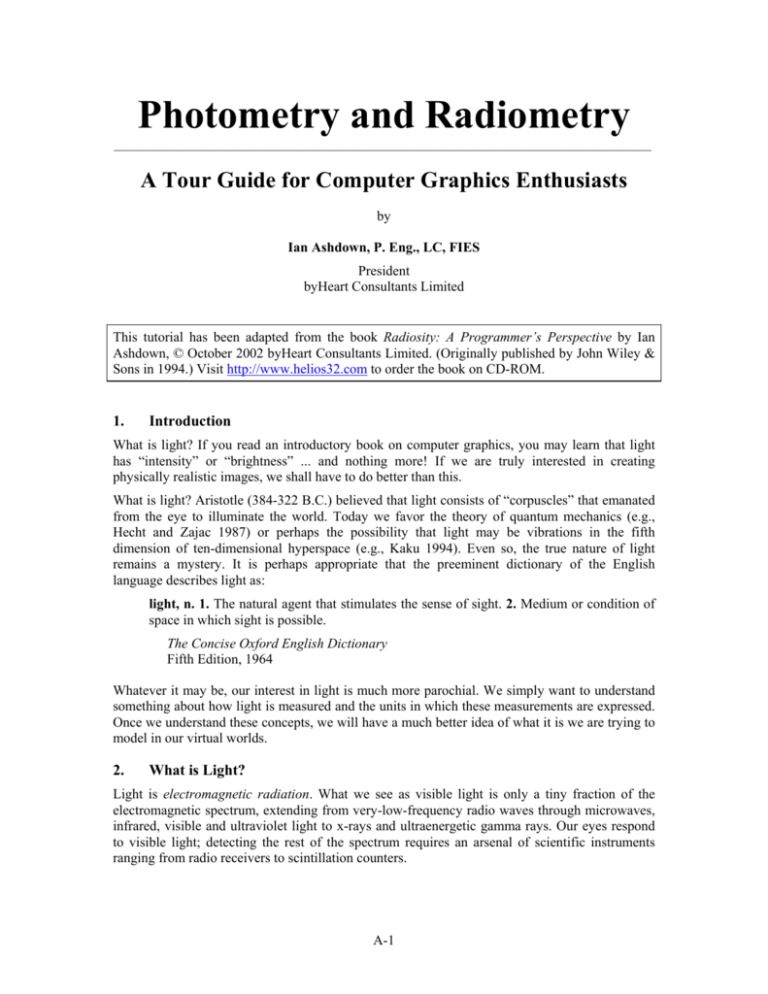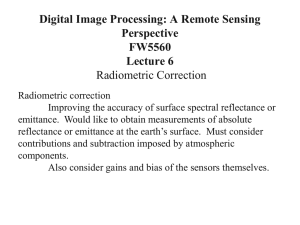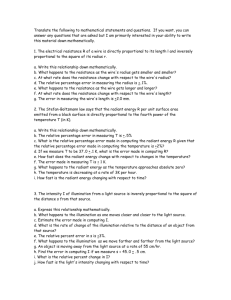Photometry and Radiometry
advertisement

Photometry and Radiometry _____________________________________________________________________________________ A Tour Guide for Computer Graphics Enthusiasts by Ian Ashdown, P. Eng., LC, FIES President byHeart Consultants Limited This tutorial has been adapted from the book Radiosity: A Programmer’s Perspective by Ian Ashdown, © October 2002 byHeart Consultants Limited. (Originally published by John Wiley & Sons in 1994.) Visit http://www.helios32.com to order the book on CD-ROM. 1. Introduction What is light? If you read an introductory book on computer graphics, you may learn that light has “intensity” or “brightness” ... and nothing more! If we are truly interested in creating physically realistic images, we shall have to do better than this. What is light? Aristotle (384-322 B.C.) believed that light consists of “corpuscles” that emanated from the eye to illuminate the world. Today we favor the theory of quantum mechanics (e.g., Hecht and Zajac 1987) or perhaps the possibility that light may be vibrations in the fifth dimension of ten-dimensional hyperspace (e.g., Kaku 1994). Even so, the true nature of light remains a mystery. It is perhaps appropriate that the preeminent dictionary of the English language describes light as: light, n. 1. The natural agent that stimulates the sense of sight. 2. Medium or condition of space in which sight is possible. The Concise Oxford English Dictionary Fifth Edition, 1964 Whatever it may be, our interest in light is much more parochial. We simply want to understand something about how light is measured and the units in which these measurements are expressed. Once we understand these concepts, we will have a much better idea of what it is we are trying to model in our virtual worlds. 2. What is Light? Light is electromagnetic radiation. What we see as visible light is only a tiny fraction of the electromagnetic spectrum, extending from very-low-frequency radio waves through microwaves, infrared, visible and ultraviolet light to x-rays and ultraenergetic gamma rays. Our eyes respond to visible light; detecting the rest of the spectrum requires an arsenal of scientific instruments ranging from radio receivers to scintillation counters. A-1 A rigorous and exact description of electromagnetic radiation and its behavior requires a thorough knowledge of quantum electrodynamics and Maxwell’s electromagnetic field equations. Similarly, a complete understanding of how we perceive the light our eyes see delves deeply into the physiology and psychology of the human visual system. There is an enormous body of literature related to the physical aspects of light as electromagnetic radiation (e.g., Hecht and Zajac 1987) and an equally enormous amount devoted to how we perceive it (e.g., Cornsweet 1977). Fortunately, our interests are extremely modest. We simply want to measure what we see and perceive. 3. Radiometry Radiometry is the science of measuring light in any portion of the electromagnetic spectrum. In practice, the term is usually limited to the measurement of infrared, visible, and ultraviolet light using optical instruments. There are two aspects of radiometry: theory and practice. The practice involves the scientific instruments and materials used in measuring light, including radiation thermocouples, bolometers, photodiodes, photosensitive dyes and emulsions, vacuum phototubes, charge-coupled devices, and a plethora of others. What we are interested in, however, is the theory. Radiometric theory is such a simple topic that most texts on physics and optics discuss it in a few paragraphs. Unfortunately, they rarely discuss the topic in enough detail to be useful. Shorn of convoluted mathematics and obtuse definitions, radiometric theory is simple and easily understood. 3.1 Radiant Energy Light is radiant energy. Electromagnetic radiation (which can be considered both a wave and a particle, depending on how you measure it) transports energy through space. When light is absorbed by a physical object, its energy is converted into some other form. A microwave oven, for example, heats a glass of water when its microwave radiation is absorbed by the water molecules. The radiant energy of the microwaves is converted into thermal energy (heat). Similarly, visible light causes an electric current to flow in a photographic light meter when its radiant energy is transferred to the electrons as kinetic energy. Radiant energy (denoted as Q) is measured in joules. 3.1.1 Spectral Radiant Energy A broadband source such as the Sun emits electromagnetic radiation throughout most of the electromagnetic spectrum, from radio waves to gamma rays. However, most of its radiant energy is concentrated within the visible portion of the spectrum. A single-wavelength laser, on the other hand, is a monochromatic source; all of its radiant energy is emitted at one specific wavelength. From this, we can define spectral radiant energy, which is the amount of radiant energy per unit wavelength interval at wavelength λ. It is defined as: Qλ = dQ dλ (1) Spectral radiant energy is measured in joules per nanometer. A-2 3.2 Radiant Flux (Radiant Power) Energy per unit time is power, which we measure in joules per second, or watts. A laser beam, for example, has so many milliwatts or watts of radiant power. Light “flows” through space, and so radiant power is more commonly referred to as the “time rate of flow of radiant energy,” or radiant flux. It is defined as: Φ = dQ dt (2) where Q is radiant energy and t is time. In terms of a photographic light meter measuring visible light, the instantaneous magnitude of the electric current is directly proportional to the radiant flux. The total amount of current measured over a period of time is directly proportional to the radiant energy absorbed by the light meter during that time. This is how a photographic flash meter works -- it measures the total amount of radiant energy received from a camera flash. The flow of light through space is often represented by geometrical rays of light such as those used in computer graphics ray tracing. They can be thought of as infinitesimally thin lines drawn through space that indicate the direction of flow of radiant energy (light). They are also mathematical abstractions -- even the thinnest laser beam has a finite cross section. Nevertheless, they provide a useful aid to understanding radiometric theory. Radiant flux is measured in watts. 3.2.1 Spectral Radiant Flux (Spectral Radiant Power) Spectral radiant flux is radiant flux per unit wavelength interval at wavelength λ. It is defined as: Φ λ = dΦ dλ (3) and is measured in watts per nanometer. 3.3 Radiant Flux Density (Irradiance and Radiant Exitance) Radiant flux density is the radiant flux per unit area at a point on a surface, where the surface can be real or imaginary (i.e., a mathematical plane). There are two possible conditions. The flux can be arriving at the surface (Fig. 1a), in which case the radiant flux density is referred to as irradiance. The flux can arrive from any direction above the surface, as indicated by the rays. Irradiance is defined as: E = dΦ dA (4) where Φ is the radiant flux arriving at the point and dA is the differential area surrounding the point. The flux can also be leaving the surface due to emission and/or reflection (Fig. 1b). The radiant flux density is then referred to as radiant exitance. As with irradiance, the flux can leave in any direction above the surface. The definition of radiant exitance is: M = dΦ dA (5) where Φ is the radiant flux leaving the point and dA is the differential area surrounding the point. A-3 dA Figure 1a dA Irradiance Figure 1b Radiant exitance The importance of a “real or imaginary” surface cannot be overstated. It means that radiant flux density can be measured anywhere in three-dimensional space. This includes on the surface of physical objects, in the space between them (e.g., in air or a vacuum), and inside transparent media such as water and glass. Radiant flux density is measured in watts per square meter. 3.3.1 Spectral Radiant Flux Density Spectral radiant flux density is radiant flux per unit wavelength interval at wavelength λ. When the radiant flux is arriving at the surface, it is called spectral irradiance, and is defined as: Eλ = dE dλ (6) When the radiant flux is leaving the surface, it is called spectral radiant exitance, and is defined as: Mλ = dM dλ (7) Spectral radiant flux density is measured in watts per square meter per nanometer. 3.4 Radiance Radiance is best understood by first visualizing it. Imagine ray of light arriving at or leaving a point on a surface in a given direction. Radiance is simply the infinitesimal amount of radiant flux contained in this ray. Period. A more formal definition of radiance requires that we think of a ray as being an infinitesimally narrow (“elemental”) cone with its apex at a point on a real or imaginary surface. This cone has a differential solid angle dω that is measured in steradians. We must also note that the ray is intersecting the surface at an angle. If the area of intersection with the surface has a differential cross-sectional area dA, the cross-sectional area of the ray is dA cos θ , where θ is the angle between the ray and the surface normal, as shown in Figure 2. (The ray cross-sectional area dA cos θ is called the projected area of the ray-surface intersection area dA. The same term is used when referring to finite areas ∆A.) With these preliminaries in mind, we can imagine an elemental cone dω containing a ray of light that is arriving at or leaving a surface (Figs. 3a and 3b). The definition of radiance is then: L = d 2 Φ [dA(dω cos θ )] (8) A-4 n Φ θ Projected area dAcos θ dA Figure 2 A ray of light intersecting a surface where Φ is the radiant flux, dA is the differential area surrounding the point, dω is the differential solid angle of the elemental cone, and θ is the angle between the ray and the surface normal n at the point. Unlike radiant flux density, the definition of radiance does not distinguish between flux arriving at or leaving a surface. In fact, the formal definition of radiance (ANSI/IES 1986) states that it can be “leaving, passing through or arriving at” the surface. Φ n Φ n θ θ dω dω dA Figure 3a Radiance (arriving) dA Figure 3b Radiance (leaving) Another way of looking a radiance is to note that the radiant flux density at a point on a surface due to a single ray of light arriving (or leaving) at an angle θ to the surface normal is dΦ (dA cos θ ) . The radiance at that point for the same angle is then d 2 Φ [dA(dω cos θ )] , or radiant flux density per unit solid angle. Radiance is measured in watts per square meter per steradian. 3.4.1 Spectral Radiance Spectral radiance is radiance per unit wavelength interval at wavelength λ. It is defined as: Lλ = d 3Φ [ dA(dω cos θ )dλ ] (9) and is measured in watts per square meter per steradian per nanometer. A-5 3.5 Radiant Intensity We can imagine an infinitesimally small point source of light that emits radiant flux in every direction. The amount of radiant flux emitted in a given direction can be represented by a ray of light contained in an elemental cone. This gives us the definition of radiant intensity: I = dΦ dω I (10) where dω is the differential solid angle of the elemental cone containing the given direction. From the definition of a differential solid angle ( dω = dA r 2 ), we get: E = dΦ dA = dΦ r 2 dω = I r 2 (11) where the differential surface area dA is on the surface of a sphere centered on and at a distance r from the source and E is the irradiance of that surface. More generally, the radiant flux will intercept dA at an angle θ (Fig. 4). This gives us the inverse square law for point sources: E = I cos θ d 2 (12) where I is the intensity of the source in the given direction and d is the distance from the source to the surface element dA. n θ d dA Figure 4 Inverse square law for point sources We can further imagine a real or imaginary surface as being a continuum of point sources, where each source occupies a differential area dA (Fig. 5). Viewed at an angle θ from the surface normal n, the source has a projected area of dA cos θ . Combining the definitions of radiance (Eqn. 8) and radiant intensity (Eqn. 10) gives us an alternative definition of radiance: L = dI (dA cos θ ) (13) where dI is the differential intensity of the point source in the given direction. Radiant intensity is measured in watts per steradian. n dI θ dA Figure 5 Radiance of a point source A-6 3.4.1 Spectral Radiant Intensity Spectral radiant intensity is radiant intensity per unit wavelength interval at wavelength λ. It is defined as: Iλ = dI dλ (14) and is measured in watts per steradian per nanometer. 4. Illumination versus Thermal Engineering The definitions given above are those commonly used in illumination engineering and are in accordance with the American National Standard Institute publication Nomenclature and Definitions for Illuminating Engineering (ANSI/IES 1986). Unfortunately, these definitions differ somewhat from those used in thermal engineering (e.g., Siegel and Howell 1981). Radiative heattransfer theory (i.e., infrared light) does not use the point source concept that is common in illumination engineering texts. Thermal engineers instead use the term “radiant intensity” to describe radiance (watts per unit area per unit solid angle). The different terminology was of little consequence until the computer graphics community adapted the concepts of radiative heat transfer to create radiosity theory. In the process of doing so it adopted thermal engineering’s terminology. This is an unfortunate situation, because computer graphics also relies on the point source concept for ray tracing. This tutorial defines radiant intensity as “watts per unit solid angle” and radiance as “watts per unit area per unit solid angle” to maintain consistency between radiosity and ray-tracing theory. Note, however, that many papers and texts on radiosity theory and some computer graphics texts define “radiant intensity” as “watts per unit area per unit solid angle.” 5. Photometry Photometry is the science of measuring visible light in units that are weighted according to the sensitivity of the human eye. It is a quantitative science based on a statistical model of the human visual response to light -- that is, our perception of light -- under carefully controlled conditions. The human visual system is a marvelously complex and highly nonlinear detector of electromagnetic radiation with wavelengths ranging from 380 to 770 nanometers (nm). We see light of different wavelengths as a continuum of colors ranging through the visible spectrum: 650 nm is red, 540 nm is green, 450 nm is blue, and so on. The sensitivity of the human eye to light varies with wavelength. A light source with a radiance of one watt/m2-steradian of green light, for example, appears much brighter than the same source with a radiance of one watt/m2-steradian of red or blue light. In photometry, we do not measure watts of radiant energy. Rather, we attempt to measure the subjective impression produced by stimulating the human eye-brain visual system with radiant energy. This task is complicated immensely by the eye’s nonlinear response to light. It varies not only with wavelength but also with the amount of radiant flux, whether the light is constant or flickering, the spatial complexity of the scene being perceived, the adaptation of the iris and retina, the psychological and physiological state of the observer, and a host of other variables. Nevertheless, the subjective impression of seeing can be quantified for “normal” viewing conditions. In 1924, the Commission Internationale d’Eclairage (International Commission on Illumination, or CIE) asked over one hundred observers to visually match the “brightness” of monochromatic light sources with different wavelengths under controlled conditions. The A-7 statistical result -- the so-called CIE photometric curve shown in Figure 6 -- shows the photopic luminous efficiency of the human visual system as a function of wavelength. It provides a weighting function that can be used to convert radiometric into photometric measurements. 1 0.9 0.8 0.7 Photopic 0.6 luminous 0.5 efficiency 0.4 0.3 0.2 0.1 0 390 440 490 540 590 640 690 740 Wavelength (nm) Figure 6 CIE photometric curve Photometric theory does not address how we perceive colors. The light being measured can be monochromatic or a combination or continuum of wavelengths; the eye’s response is determined by the CIE weighting function. This underlines a crucial point: The only difference between radiometric and photometric theory is in their units of measurement. With this thought firmly in mind, we can quickly review the fundamental concepts of photometry. 5.1 Luminous Intensity The foundations of photometry were laid in 1729 by Pierre Bouguer. In his L’Essai d’Optique, Bouguer discussed photometric principles in terms of the convenient light source of his time: a wax candle. This became the basis of the point source concept in photometric theory. Wax candles were used as national light source standards in the 18th and 19th centuries. England, for example, used spermaceti (a wax derived from sperm whale oil). These were replaced in 1909 by an international standard based on a group of carbon filament vacuum lamps and again in 1948 by a crucible containing liquid platinum at its freezing point. Today the international standard is a theoretical point source that has a luminous intensity of one candela (the Latin word for “candle”). It emits monochromatic radiation with a frequency of 540 x 1012 Hertz (or approximately 555 nm, corresponding with the wavelength of maximum photopic luminous efficiency) and has a radiant intensity (in the direction of measurement) of 1/683 watts per steradian. Together with the CIE photometric curve, the candela provides the weighting factor needed to convert between radiometric and photometric measurements. Consider, for example, a monochromatic point source with a wavelength of 510 nm and a radiant intensity of 1/683 watts per steradian. The photopic luminous efficiency at 510 nm is 0.503. The source therefore has a luminous intensity of 0.503 candela. 5.2 Luminous Flux (Luminous Power) Luminous flux is photometrically weighted radiant flux (power). Its unit of measurement is the lumen, defined as 1/683 watts of radiant power at a frequency of 540 x 1012 Hertz. As with luminous intensity, the luminous flux of light with other wavelengths can be calculated using the CIE photometric curve. A-8 A point source having a uniform (isotropic) luminous intensity of one candela in all directions (i.e., a uniform intensity distribution) emits one lumen of luminous flux per unit solid angle (steradian). 5.3 Luminous Energy Luminous energy is photometrically weighted radiant energy. It is measured in lumen seconds. 5.4 Luminous Flux Density (Illuminance and Luminous Exitance) Luminous flux density is photometrically weighted radiant flux density. Illuminance is the photometric equivalent of irradiance, whereas luminous exitance is the photometric equivalent of radiant exitance. Luminous flux density is measured in lumens per square meter. (A footcandle is one lumen per square foot.) 5.5 Luminance Luminance is photometrically weighted radiance. In terms of visual perception, we perceive luminance. It is an approximate measure of how “bright” a surface appears when we view it from a given direction. Luminance used to be called “photometric brightness.” This term is no longer used in illumination engineering because the subjective sensation of visual brightness is influenced by many other physical, physiological, and psychological factors. Luminance is measured in lumens per square meter per steradian. 6. Lambertian Surfaces A Lambertian surface is a surface that has a constant radiance or luminance that is independent of the viewing direction. In accordance with the definition of radiance (luminance), the radiant (luminous) flux may be emitted, transmitted, and/or reflected by the surface. A Lambertian surface is also referred to as an ideal diffuse emitter or reflector. In practice there are no true Lambertian surfaces. Most matte surfaces approximate an ideal diffuse reflector but typically exhibit semispecular reflection characteristics at oblique viewing angles. Nevertheless, the Lambertian surface concept is useful in computer graphics. Lambertian surfaces are unique in that they reflect incident flux in a completely diffuse manner (Fig. 7). It does not matter what the angle of incidence θ of an incoming geometrical ray is -- the distribution of light leaving the surface remains unchanged. We can imagine a differential area dA of a Lambertian surface. Being infinitesimally small, it is equivalent to a point source, and so the flux leaving the surface can be modeled as geometrical rays. The intensity Iθ of each ray leaving the surface at an angle θ from the surface normal is given by Lambert’s cosine law: Iθ = In cos θ (15) where Ιn is the intensity of the ray leaving in a direction perpendicular to the surface. A-9 n θ dA Figure 7 Reflection from a Lambertian surface The derivation of Equation 15 becomes clear when we remember that we are viewing dA from an angle θ. For a differential area dA with a constant radiance or luminance, its intensity must vary in accordance with its projected area, which is dA cos θ . This gives us: L = dI (dA cos θ ) = dIn dA (16) for any Lambertian surface. There is a very simple relation between radiant (luminous) exitance and radiance (luminance) for flux leaving a Lambertian surface: M = πL (17) where the factor of π is a source of endless confusion to students of radiometry and photometry. Fortunately, there is an intuitive explanation. Suppose we place a differential Lambertian emitter dA on the inside surface of an imaginary sphere S (Fig. 8). The inverse square law (Eqn. 12) provides the irradiance E at any point P on the inside surface of the sphere. However, d = D cos θ , where D is the diameter of the sphere. Thus: E = Iθ cos θ ( D cos θ ) = Iθ D2 cos θ 2 (18) n Sphere S P D θ θ d dA Figure 8 A Lambertian emitter illuminating the interior of a sphere and from Lambert’s cosine law (Eqn. 15), we have: E = Iθ cos θ D2 cos θ = In D2 (19) A-10 which simply says that the irradiance (radiant flux density) of any point P on the inside surface of S is a constant. This is interesting. From the definition of irradiance (Eqn. 4), we know that Φ = EA for constant flux density across a finite surface area A. Since the area A of the surface of a sphere with radius r is given by: A = 4πr 2 = πD2 (20) we have: Φ = EA = πIn D2 D2 = πIn (21) Given the definition of radiant exitance (Eqn. 5) and radiance for a Lambertian surface (Eqn. 16), we have: M = dΦ dA = πdIn dA = πL (22) This explains, clearly and without resorting to integral calculus, where the factor of π comes from. 7. What is Radiosity? ANSI/IES (1986) does not define or even mention the term “radiosity.” This is not unusual -there are many photometric and radiometric terms whose use is no longer encouraged. “Illuminance,” for example, used to be called “illumination.” It was changed to “illuminance” to avoid confusion with “the act of illuminating or the state of being illuminated” (ANSI/IES 1986). When Moon wrote The Scientific Basis of Illumination Engineering in 1936, luminous exitance was called “luminosity.” Curiously, there was no equivalent term for “radiant exitance,” so he coined the term “radiosity” to describe the density of radiant flux leaving a surface. The illumination engineering community ignored Moon’s proposal. Luminosity was changed to “luminous emittance” and later to “luminous exitance,” with “radiant exitance” following as a consequent. Meanwhile, the thermal engineering community adopted “radiosity” (e.g., Siegel and Howell 1981). It’s all very confusing. Fortunately, we only need to remember that: Radiosity is radiant exitance. This tutorial takes exception, perhaps unwisely, to the computer graphics community’s use of the term “radiosity” to describe radiant exitance. Whereas it is an accepted term within the thermal engineering community, it is not acceptable to illumination engineers for a variety of historical reasons. The computer graphics and illumination engineering communities have many common interests. If we are to communicate effectively, we must use a common lexicon of definitions. That lexicon is ANSI/IES (1986). 8. Conclusions There is much more that we have not covered here, such as reflectance, transmittance, absorption, scattering, diffraction, and polarization. We have also ignored the interaction of the human visual system with light, including scoptic and mesopic luminous efficiency, temporal effects such as flicker, and most important, color perception. The study of light and how we perceive it fills volumes of research papers and textbooks. A-11 Nevertheless, it begins with an understanding of how we measure light. While there is more to it than “intensity,” you can see from this tutorial that radiometric and photometric theory is conceptually simple and easily understood. 9. References ANSI/IES. 1986. Nomenclature and Definitions for Illuminating Engineering, ANSI/IES RP-161986. New York, NY: Illuminating Engineering Society of North America. Bouguer, P. 1729. L’Essai d’Optique. Paris. Cornsweet, T. N. 1977. Visual Perception. Cambridge, MA: Academic Press. Hecht, E. and A. Zajac. 1987. Optics (2nd ed.) Reading, MA: Addison-Wesley. Kaku, M. 1994. Hyperspace. Oxford, UK: Oxford University Press. Moon, P. 1936. The Scientific Basis of Illumination Engineering. New York, NY: McGraw-Hill. Siegel, R. and J. R. Howell. 1981. Thermal Radiation Heat Transfer. Washington, DC: Hemisphere Publishing. A-12







